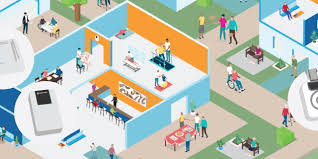 Moving in later can mean greater care needs, but same staffing levels. This article caught my eye – ‘Significantly more difficult’ to care for today’s assisted living residents. The gist of the story is that people are moving in later, now in their mid-80’s and often because living at home is untenable. Which means they need more help and care than the organizations used to expect. According to AHCA/NCAL: ”Four in 10 are living with Alzheimer’s disease or other dementias. After a median stay around 22 months, roughly 60% of residents will move out of assisted living to transition to a skilled nursing center.”
Moving in later can mean greater care needs, but same staffing levels. This article caught my eye – ‘Significantly more difficult’ to care for today’s assisted living residents. The gist of the story is that people are moving in later, now in their mid-80’s and often because living at home is untenable. Which means they need more help and care than the organizations used to expect. According to AHCA/NCAL: ”Four in 10 are living with Alzheimer’s disease or other dementias. After a median stay around 22 months, roughly 60% of residents will move out of assisted living to transition to a skilled nursing center.”
Assisted living organizations struggle to staff for the needs of today’s residents. Using the term ‘changing acuity’ hides a crisis for care delivery providers. Consider that 44% of assisted living residents have dementia, need help with walking, dressing and bathing as well as transferring to a chair. With a nationwide staffing ratio of 1:8 during the day and as much as 1:15 during the night, the physical workload is daunting. And with unanticipated absences, communities often call on home care agencies to fill in staffing gaps, for example on weekends.
AI technology can help with some of the staffing challenges. Chatbots are already being deployed as a sales tool for senior living, freeing up phone staffing and front desk resources. One option for chatbots, staff education, can be used for guiding new staff members about resident health conditions – before approaching the room. Today it is feasible and underway to do the following: documentation transcription/scribing of care notes, automated assistance in creation of care plans, linking behavioral data with electronic health records, and using sensors to track resident movement and calculate frailty scores. AI technology is also being used today to make recruiting more efficient at finding the right people for job openings
Physical tasks still need to be done – AI should help with the rest. Despite CES demos, enthusiastic marketing documents and PR from Japan, robots have not received broad use in assisted living in the US today. One reason, according to an MIT Tech Review article, is that they create MORE work for caregivers and can cost as much as $85,000 per year. For now, it is unlikely that there will be broad adoption of robots in senior living for the near-term future. Instead, senior living organizations will likely step up their efforts to optimize their work processes by making greater use of AI tools.
[See the recent report: The Future of AI in Senior Living and Care: What’s Now and Next]

 Moving in later can mean greater care needs, but same staffing levels. This article caught my eye – ‘
Moving in later can mean greater care needs, but same staffing levels. This article caught my eye – ‘